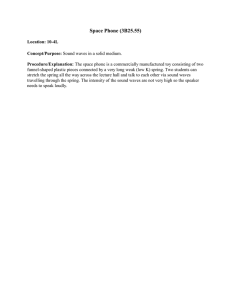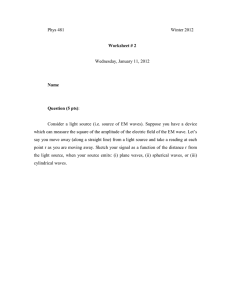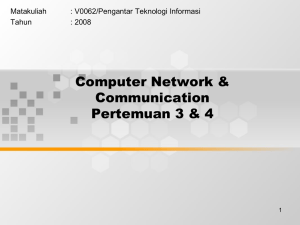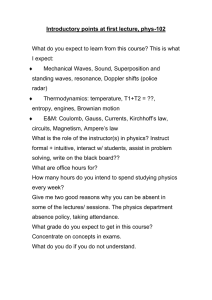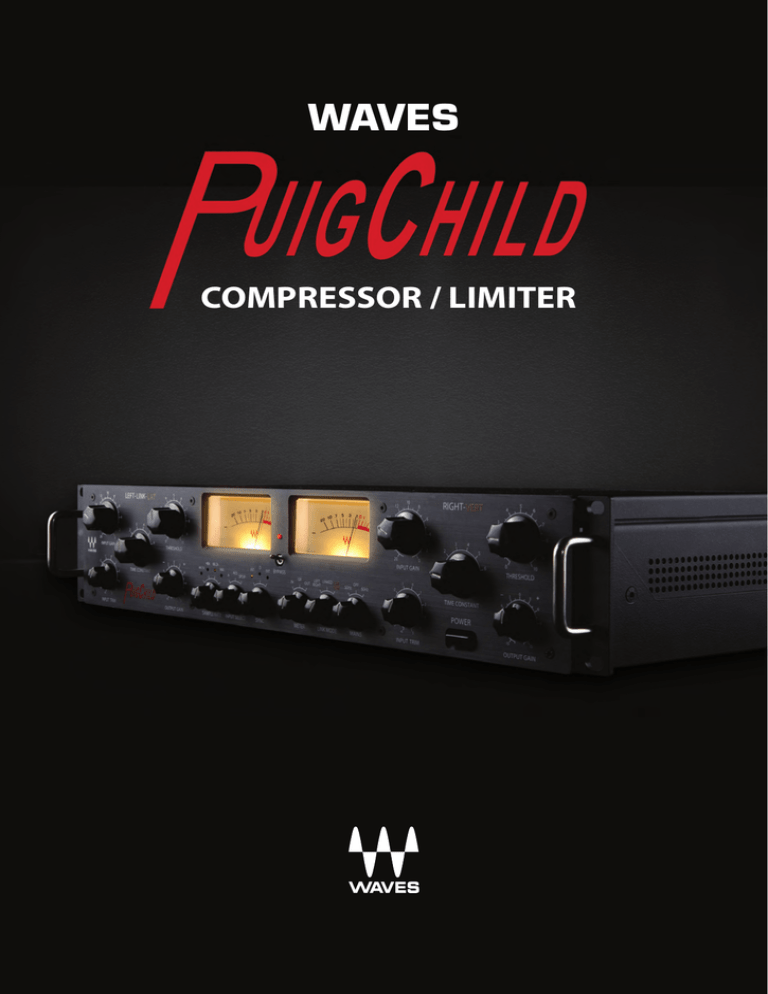
WAVES
COMPRESSOR / LIMITER
Los Angeles, CA
November 2011
It’s just fantastic that one of my favorite pieces of gear has been resurrected
in a 21st century incarnation: the classic Fairchild 670!
The PuigChild compressor truly captures the vibe of the original, and as a
piece of hardware, it allows us to have the same tactile experience with the
same unique sound. The new unit also has excellent high definition input
and output converters that deliver the maximum representation of the
remarkable modeling of the 670. It’s like a dream come true. I hope you all
enjoy it as much as I do; it’s quickly become one of my go-to compressors.
My Best,
Jack Joseph Puig
3
Table of Contents
IMPORTANT SAFETY CONSIDERATIONS
5
Package Contents
6
Introduction7
4
Internal Processing
8
Controls Overview
9
Connecting the PuigChild
11
Input/Output Calibration Controls 13
Rear Panel Sync & Word Clock Connections 13
Front Panel Controls – In Depth
14
Connection Examples
17
Technical Specifications
18
Troubleshooting & Frequently Asked Questions
19
Contact Waves Sales and Technical Support
20
One Year Limited Warranty 20
IMPORTANT SAFETY CONSIDERATIONS
Securely mount the Waves PuigChild in a 19” studio rack away from rain, moisture, liquids,
heat sources or fire using the four supplied mounting bolts. (Plastic washers are provided to
prevent scratching). Apply the rubber feet for desktop use.
In case of damage to the Waves PuigChild due to spilled liquids or physical damage from
knocks or dropping, repairs should be performed by qualified service personnel only.
Read all operating instructions.
Do not allow children to use the PuigChild without adult supervision.
Do not overload audio inputs or outputs. Waves will not be responsible for damage caused to
other equipment (such as speakers) through misuse.
Do not block the ventilation grills that are located on the sides of the unit.
PLEASE NOTE: THE POWER SUPPLY IS NOT AUTO-SWITCHING!
You must check to make sure the voltage rating shown directly on the back panel of your
Waves PuigChild is appropriate for your power connection. Please see the diagram below. To
change voltage, gently pull out the fuse holder. It can be pried out by inserting a screwdriver
under the edge by the IEC plug and pulling out gently. Insert it back with the desired voltage
positioned according to the 4 diagrams below. Make sure that the desired voltage marking is
at the top of the compartment.
Please read, complete and return by mail the Warranty Registration Form entitling you to
technical support and service under warranty.
WARNING: CLASS 1 LASER PRODUCT (SINGLE-MODE)
5
Package Contents
•
•
•
•
•
•
•
•
1x Waves PuigChild compressor
110 v USA power cable
220 v European power cable
Three (3) sets of four (4) mounting bolts each
Spare fuse
Four (4) rubber “feet”
Four (4) plastic washers
User manual
Unpacking the Waves PuigChild
After unpacking the PuigChild unit, please check it carefully for any damage. If any damage is
found, immediately notify the carrier that brought you the package. You, the consignee, must
initiate any claim. Please retain all packaging in case of future re-shipment.
Mounting the PuigChild
Before connecting the PuigChild, be sure to securely mount it in a standard 19” studio rackmount away from heat and moisture. We recommend using the supplied plastic washers
between the PuigChild and the mounting bolts to protect the PuigChild’s front panel from
scratches. Alternatively, for desktop use, attach the four rubber feet to the bottom of the
PuigChild.
6
Introduction
Thank you for choosing the Waves PuigChild. Be sure to read the safety considerations before
you plug in and switch on the PuigChild’s power. Please spend some time reading through this
manual so that you obtain the best possible performance from the unit. For more information
about our products, please visit www.waves.com.
Features
•
•
•
•
•
Full 48-bit internal processing
Supports sampling rates up to 96kHz
A wide variety of analog and digital connectors for compatibility with all popular formats
16/24-bit digital I/O
Outstanding AD/DA conversion using 24-bit converters and transformer-based analog
input/output stages
About the PuigChild
Among gear aficionados, the stereo Fairchild 670 is considered the most coveted of all
compressors, not only because of its pristine sound, but also its rarity and price: 670s routinely
go for tens of thousands of dollars on the vintage market. (They originally cost less than $1000).
With 20 vacuum tubes and 11 hand-wired transformers in a hefty 6 rack-space chassis, these
hard-to-find units weigh in at a robust 65 lbs.
Designed by Estonian-born Rein Narma in the early 1950s, both the stereo 670 and its mono
counterpart the Fairchild 660 use single push-pull amplification stages with extremely high
control voltages. Both variable-mu limiters are unique in that they use tubes for gain reduction
as well as amplification. Compression takes place directly in the audio path, rather than being
routed to a separate circuit.
Prior to the 660 and 670, Narma’s Gotham Audio Developments had built consoles and
components for such luminaries as Rudy Van Gelder and Les Paul. Shortly after Paul asked
Narma to build a limiter, Sherman Fairchild caught wind of the project, licensed the design,
and hired Narma to come onboard as the company’s chief engineer. After his stint at Fairchild,
Narma relocated to the San Francisco Bay Area and became vice president of Ampex, pioneers
of multitrack recording equipment.
About the Modeling
Many different elements contribute to the unique sonic characteristics of analog gear such
as the Fairchild 670. Waves painstakingly modeled and incorporated these elements into the
PuigChild in order to fully capture and replicate the sound and performance of the original
equipment.
7
These are some of the most important elements of analog behavior:
• Total Harmonic Distortion
Perhaps the most important analog behavior is Total Harmonic Distortion or THD, which
is defined as the ratio of the sum of the powers of all harmonic components to the power
of the fundamental frequency. THD is usually caused by amplification, and changes signal
shape and content by adding odd and even harmonics of the fundamental frequencies,
which can change the overall tonal balance. THD can also change peak output gain, usually
by no more than +/- 0.2-0.3 dB.
• Transformers
Some hardware uses transformers to stabilize or change Input/Output loads and signal levels.
In earlier days, transformers did not have a flat frequency response, and often introduced
low and super-high frequency roll offs. The original Fairchild has four transformers, so if you
encounter a low or extremely high frequency loss, this is due to the modeled transformers.
• Long Release Times
The Fairchild includes settings which use long time constants of several seconds. This might
cause short looped passages to sound different during successive playbacks, because the
Release never returns to unity. This is identical to the original hardware performance, and
should not be a cause for concern.
• Hum
Waves modeled both 50Hz power current and 60Hz power current. If you listen closely,
you will hear that there is a difference in hum level between 50Hz and 60Hz. Since hum is
unique to each region and dependent upon the local electrical conditions, you may find
that the modeled hum is different than the hum already present in your studio, and may not
be suitable for your particular use.
Internal Processing
The PuigChild performs all digital processes with 48-bit internal precision (double precision).
The internal processing is followed by re-quantization (wordlength reduction) from the
internal 48-bit data to 16 or 24-bit output wordlengths. (Analog output always used the full
24-bit wordlength). The system can also be used to re-quantize 24-bit input signals to 16-bit
(via the digital outputs only).
8
Controls Overview
Global Controls
1.
2.
3.
4.
5.
6.
Sample Rate controls operating sample rate.
Input Select controls input type.
Sync chooses sync source.
Meter chooses which audio signal will be displayed: input, gain reduction or output.
Link Mode controls the relationship between the left channel and the right channel.
Mains controls analog characteristics caused by noise floor and hum, based on the power
supplies of the original units.
Compressor Controls
7. Input controls (analog input gain & digital input trim) the volume of the signal entering
the audio compression path.
8. Threshold sets the amount of signal compression.
9. Time Constant controls the fixed Attack and Release lengths.
10. Output controls the output level.
9
Rear Panel
1.
2.
3.
4.
10
Main Power Supply connects the PuigChild to the power supply.
Word Clock provides digital synchronization interface.
Digital I/O Interface allows digital I/O connection of various types.
Analog I/O Interface allows analog I/O connection of various types.
Connecting the PuigChild
Main Power Supply: 100, 120, 220 or 240 volt selectable
PLEASE NOTE: THE POWER SUPPLY IS NOT AUTO-SWITCHING!
You must make sure the voltage rating shown on the back panel of your PuigChild is appropriate
for your power connection.
The power cable socket and fuse-holder with voltage selector are located together on the
back panel of the PuigChild. Plug the supplied cable into the back of the PuigChild and into
your power connection. Switch on the PuigChild using the on/off power switch located on the
front panel. When you switch the power on, the front panel LED displays will illuminate.
Replacing the Fuse
If the fuse blows, switch off the power and unplug the unit. Pull off the fuse holder (see diagram
above) and replace the fuse. Do not forget to replace it with the proper voltage selection
indicated!
We suggest using the following UL listed (slow-blow) fuses:
• For 100/120 V, use a 200 mA fuse
• For 220/240 V, use a 100 mA fuse
11
Rear Panel Analog Connections
The PuigChild accepts the following connectors:
•
•
•
XLR/TRS combo inputs connector type for balanced / unbalanced in-puts.
XLR connector type for balanced outputs.
TRS (1/4”) jack connector type for balanced or unbalanced outputs.
Rear Panel Digital Connections
The PuigChild accepts the following digital inputs and outputs:
•
•
•
XLR type input/output connectors for AES/EBU signals.
RCA type input/output connectors for S/PDIF signals.
Optical type input/output connectors for S/PDIF signals.
S/PDIF input/output uses either RCA or Optical
connectors. The input format is selected using
the Coaxial/Optical selector switch.
Please note: When working in analog mode (A) and selecting sync to Digital (D), the
PuigChild sync to AES input only.
12
Input/Output Calibration Controls
The calibration controls are used to adjust the signal output that runs from your analog device
to the PuigChild’s input, and the analog output of the PuigChild to the next unit in the signal
chain, allowing you the maximum available headroom.
Input Calibration
Set your analog device to its maximum output level and set the input rotary switches on the
PuigChild front panel to unity gain. Then, adjust the input calibration so that your peak signals
are between -6 and 0 dBFS on the input meters.
Output Calibration
To adjust the PuigChild’s output, set the calibration control so that the input level on your
analog device that follows the PuigChild in the signal chain does not exceed unity gain.
Calibration Options
Input: + 9, 12, 15, 18, 20, 24 dBu
Output: + 9, 12, 15, 18, 20, 24 dBu
Rear Panel Sync & Word Clock Connections
The PuigChild can be connected to an external word clock source
(using a BNC connection) or you can use its internal clock. An external
word clock is utilized for applications that require synchronization
with other digital audio devices. The internal clock setting is selected
on the front panel only when using the PuigChild’s analog inputs.
The Termination on/off switch enables the PuigChild to perform
wordlength impedance-matching when multiple word clock
sources are chained together. Correct termination of word clock
inputs is crucial for a stable clock configuration. As the frequency
of a word clock signal increases, termination requirements become
more critical for precise transmission. In order to ensure the integrity of the clock waveform,
each connection should be terminated by a 75 ohm load impedance. Over-termination (load
impedance lower than 75 ohms) will attenuate the signal excessively, while under-termination
(load impedance greater than 75 ohms) introduces overshoot and other waveform distortions.
Both conditions compromise clock accuracy.
13
Front Panel Controls – In Depth
1.Sample Rate selects / displays the PuigChild sampling rate. PuigChild supports operating
sample rates up to 96 kHz. You can only change the signal sample rate when the PuigChild’s
Sync mode is set to Internal. At the other settings the PuigChild locks to the digital stream or
external Word Clock source. The PuigChild will automatically detect and display the sample
rate for all other Sync modes.
Options: 44.1 kHz, 48 kHz, 88.2 kHz, 96 kHz
2.Input Select selects / displays currently active PuigChild input. Note that the audio is always
sent to all outputs concurrently, regardless of the selected input source.
Options: A=Analog, SPDIF=S/PDIF (RCA / Optical)*, AES = AES (XLR)
3.Sync selects / displays the synchronization source for PuigChild. Rotate the Sync knob
to select sync source. The Internal (INT) setting uses PuigChild’s internal clock. Digital (D)
synchronizes with the digital input signal (AES/EBU or SPDIF). Word Clock (WC) syncs to an
external word clock source connected to PuigChild’s Wordclock BNC input located on the
rear panel. If sync signal is lost, the Sync LED will flash.
Options: INT = Internal, D = Digital S/PDIF (RCA) or AES (XLR), WC = External word clock synchronization.
4.Meter chooses which audio signal will be displayed on the VU meters.
Options: IN = Input, GR = Gain Reduction, OUT = output
14
5.Link controls the relationship between the left (upper) channel and the right (lower)
channel.
States
Left/Right, Linked, Lateral/Vertical
Left/Right
The compressor acts as two completely separate compressors, with the option to separately
adjust all controls per channel. This mode can significantly change the stereo image of a
stereo signal.
Link
Both channels are linked to one another. upper channel controls both channels,while lower
channels are inactive. The compression detector will calculate the maximum level of the
two channels combined, and compress both channels according to the maximum level. This
mode better preserves the stereo image of a signal.
Lateral/Vertical
Feeds the stereo signal through a sum/difference matrix which splits the stereo signal into
sum (fed to the upper/left channel) and difference (fed to the lower/right channel). The
input level is set after the matrix, so the relationship between the sum and the difference
channels can be controlled. At the compressor output, the signal passes through a second
matrix which turns it back into a Left/Right stereo signal. (Output gain occurs before the
second matrix).
6.Mains control analog characteristics caused by noise floor and hum, based on the power
supplies of the original units.
Range: Off, 50Hz, 60Hz
7.Input Gain/Trim controls the volume of the signal entering the audio compression path.
Input Trim
Controls the level of the analog input
Range: -6 to +5 dB
Resolution: 1 dB steps
Input Gain
Controls the volume of the signal entering the digital audio compression path.
Range: -20 to 0 dB
Resolution: 1dB steps
Note: -12dB is unity gain (input = output)
15
8.Threshold sets the amount of signal compression.
Range: 0 to10
Resolution: 0.1 steps
Please note: The scale is not linear, and has been adjusted to conform to the exact
scaling of the modeled unit. Thus, there may be more compression than expected at
certain steps, as with analog gear.
9.Time Constants controls the fixed Attack and Release lengths. The position values are based
on the original values, as publicized by Fairchild. Our measurements, however, differed
considerably from the values given. Therefore, we suggest using these values as a rough
guide, based on 10 dB of compression.
Range: 1 to 6
Resolution: 1, 2, 3, 4, 5, 6
Position 1 Attack: .2 ms
Release: 0.3 seconds
Position 2 Attack: .2 ms
Release: 0.8 seconds
Position 3 Attack: .4 ms
Release: 2 seconds
Position 4 Attack: .4 ms
Release: 5 seconds
Position 5 Attack: .4 ms
Release: Automatic based on program material — 2 seconds for individual peaks,
10 seconds for multiple peaks
Position 6 Attack: .2 ms
Release: Automatic based on program material — 0.8 seconds for individual peaks,
10 seconds for multiple peaks, 25 seconds for consistent high program level.
10. Output controls the output level.
Range: -18 dB to +18 dB (in 0.1 dB steps)
16
Connection Examples
Digital Mixing Desk Insert/FX (Individual Channels, Bus/Group)
Connect a send point or an insert point from the mixing desk to the appropriate digital input
of the PuigChild. Connect the PuigChild’s digital output to the Send/Insert return point.
If your console has word clock, it can be used, although it is easier to simply select D (Digital)
on the PuigChild’s front panel Sync selector. If you are using a master word clock to sync several
devices, you can use the word clock sync input on the PuigChild, and select the WC (word
clock) sync source. In either scenario, your mixer will be the master clock.
PuigChild as Analog Insert (Individual Channels, Bus/Group)
PuigChild and MaxxBCL on Master Outs for Live and Recording
17
Technical Specifications
Maximum Analog Input Gain: 24 dBu
Input Impedance, Balanced Input:
32 kOhm @ 1kHz
Front Panel
I/O selector: Analog, AES (XLR), S/PDIF
(RCA/Optical) Sync: Internal, Digital,
external word sync
Sample Rates: 44.1, 48, 88.2, 96 kHz
ADC (@ 44.1 kHz)
Frequency response: 10 Hz - 24 kHz / -0.1
dB @ 10 Hz ÷ 0.01 @ 24k THD + Noise:
< 0.0006 % (-104 dB) @ 1 kHz -1dBFS
THD 3rd Harmonic: -126 dBFS @1 kHz,
-10 dBFS
DAC (@ 44.1 kHz)
Frequency response: 20 Hz-21 kHz / - 0.4
dB @ 20 Hz ÷ 0.05 dB @ 21 kHz Noise:
< -108 dB (unweighted)
THD+Noise: < 0.003% (-90 dB) @ 1 kHz,
-1dBFS Maximum Output: +24 dBu
Output Impedance: 600 ohms @ 1 kHz
Crosstalk: < -102 dB (1 kHz, 0 dBFS )
Analog Output Stage
Maximum Output: +24 dBu
Output Impedance 600Ω
Latency (in Samples)
Digital-to-Digital
• 4 @ 44.1, 48K sampling rates
• 5 @ 88.2, 96K sampling rates
Analog-to-Analog
• 95 @ 44.1, 48K sampling rates
• 58 @ 88.2, 96K sampling rates
18
Control
Range
Input Gain
-20 to 0
Threshold
0 to 10 (0.1 steps)
Time
Constant
1, 2, 3, 4, 5, 6
On/Off
On, Off
Mains
Off, 50 Hz, 60 Hz
Left/Right, Linked,
Link
Lat/Ver
Output
-18 dB to 18 dB
(0.1 steps)
Back Panel
Analog input: XLR/1/4” Jack Combo Input Lift/Ground: Toggle Switch
Analog output: Balanced XLR, unbalanced 1/4” 2-conductor phone plug Output Lift/Ground:
Toggle Switch
Digital input/output: AES (XLR), S/PDIF (RCA), S/PDIF (Optical) SPDIF output selector: Toggle
Switch
External word clock: BNC connector
Word Clock Termination: Toggle Switch – 75Ω (On) / 1M Ω (Off )
Main power supply: Linear Power Supply Adjustable Fuse: 100VAC, 110VAC, 220VAC, 240VAC.
50-60Hz
Dimensions
Box Width (behind the front panel): Metric - 440 mm, Imperial - 17 3/8” Height: Metric- 85 mm,
Imperial- 3 3/8”
Depth: Metric- 220 mm, Imperial- 8 5/8” 2U 19” Standard Rackmount
PuigChild’s front panel contains four 6mm diameter bolt fastening holes Weight: 4.0kg (8.8
pounds)
Troubleshooting & Frequently Asked Questions
There are little clicks and pops, like some type of static, when using the PuigChild.
This is nearly always a synchronization issue. Make sure that your Sync selection is proper. If
you are using digital inputs, then you should select (D) for Digital sync, to lock to the selected
digital input. This gives the lowest jitter performance and should solve any clock problems.
If for some reason you have the Sync set to Internal while using a Digital input, it is nearly
guaranteed that you’ll have clicks and pops.
What is the advantage of 48-bit resolution when all of my audio ends up at 16-bit?
It’s a great advantage even if you start with 16-bit audio (which most of the world will do for
awhile). Just think of it as more accurate audio math, because it is! Using 48-bit math simply
keeps track of more detail while the processing is going on. Multiply 2 decimal numbers
together, and nearly always you get a number with a longer decimal; that is precisely what is
happening with 48-bit audio and dithering to your final output. The resulting resolution is as
good as you can get, preserving as much detail as pos-sible.
19
Contact Waves Sales and Technical Support
Before writing or calling Waves for technical support, please first check www.wavesupport.net
for technical support issues and the latest information. Email tech support is preferred, and is
more efficient for providing complete documentation to you. We hope you get the most from
your new PuigChild. Please contact us should you experience any problems or want to know
more about Waves.
Waves Inc.
2800 Merchants Drive
Knoxville, TN 37912
Phone: 1-865-909-9200
Fax: 1-865-909-9245
Waves Audio Ltd.
Azrieli Center 3
The Triangle Tower, 32nd Floor
Tel-Aviv 67023, Israel
Phone: +972-3-608-4000
Fax: +972-3-608-4056
sales.waves.com
www.wavesupport.net
©2011 Waves Audio Ltd. All rights reserved worldwide. All features and specifications subject
to change without notice.
20
One Year Limited Warranty
Waves Audio Ltd. (“Waves”) warrants that the Product conforms substan-tially to the
specifications contained in the Product’s documentation for a period of one (1) year from the
date of original purchase from Waves or its authorized resellers. In the case of a valid warranty
claim, your sole and exclusive remedy and Waves’ entire liability under any theory of liability
will be, at its option, to repair or replace the Product without charge or, if this is not possible,
to refund the purchase price to you. For warranty service, please call one of Waves’ offices
listed above, to obtain a Return Autho-rization (RA) number. After you obtain the RA number,
ship the defective Product, transportation and insurance charges prepaid, to a Waves location listed above. Write the RA number in large letters on the outside of the shipping box.
Enclose your name, address, telephone number, copy of original sales invoice and a detailed
description of the problem. Waves will not accept responsibility for loss or damage in transit.
The Warranty is void if the Product serial numbers have been removed from the Product or if
the Product has been damaged by misuse, modification or unauthorized repair, as determined
at Waves’ sole discretion.
The Product is designed and manufactured for use in professional and stu-dio audio systems
and is not intended for other usage.
This limited warranty, with all terms, conditions and disclaimers set forth herein, shall extend
to the original purchaser and anyone who purchases the Product within the specified warranty
period. This limited warranty gives you certain rights. You may have additional rights provided
by applicable laws.
Waves does not authorize any third party, including any dealer or sales representative, to
assume any liability or make any additional warranties or representation regarding this Product
information on behalf of Waves.
THIS WARRANTY IS IN LIEU OF ALL WARRANTIES, WHETHER ORAL OR WRITTEN, EXPRESS,
IMPLIED OR STATUTORY. WAVES MAKES NO OTHER WARRANTY, EITHER EXPRESS OR IMPLIED,
INCLUDING, WITHOUT LIMITATION, ANY IMPLIED WARRAN-TIES OF MERCHANTABILITY, FITNESS
FOR A PARTICULAR PURPOSE, OR NON-IN-FRINGEMENT. PURCHASER’S SOLE AND EXCLUSIVE
REMEDY UNDER THIS WAR-RANTY SHALL BE REPAIR OR REPLACEMENT AS SPECIFIED HEREIN.
IN NO EVENT WILL WAVES BE LIABLE FOR ANY DIRECT, INDIRECT, SPECIAL, IN-CIDENTAL OR
CONSEQUENTIAL DAMAGES RESULTING FROM ANY DEFECT IN THE PRODUCT, INCLUDING
LOST PROFITS, DAMAGE TO PROPERTY AND, TO THE EXTENT PERMITTED BY LAW, DAMAGE
FOR PERSONAL INJURY, EVEN IF WAVES HAS BEEN ADVISED OF THE POSSIBILITY OF SUCH
DAMAGES.
Some states do not allow the exclusion or limitation of certain warranties, so the above
limitations may not apply to you. This warranty gives you specific legal rights. You may have
other rights, which vary, state to state.
21
Governing Law and Severability
This agreement will be governed by the laws of Israel. If a court finds any provision of this
License unenforceable, that provision will be enforced to the maximum extent possible, and
the remainder of the License shall con-tinue in full force and effect. In the event of a dispute
arising under this Agreement, you consent to sole and exclusive jurisdiction in the State of
Israel.
22
www.waves.com

